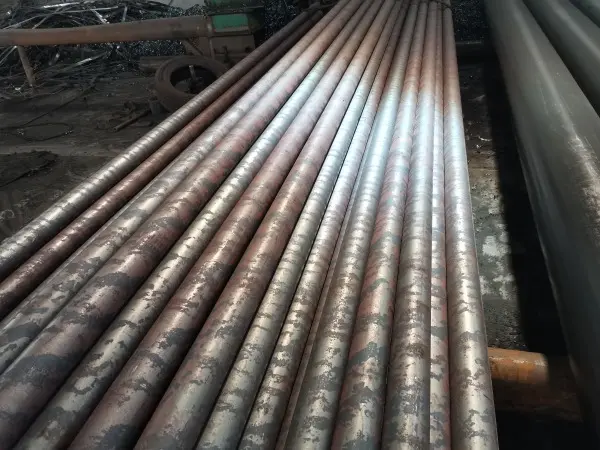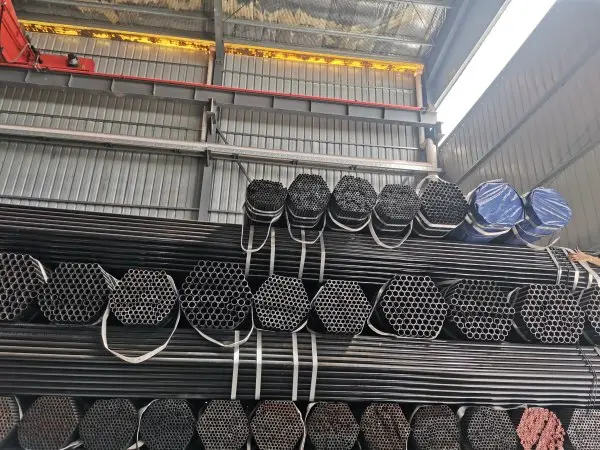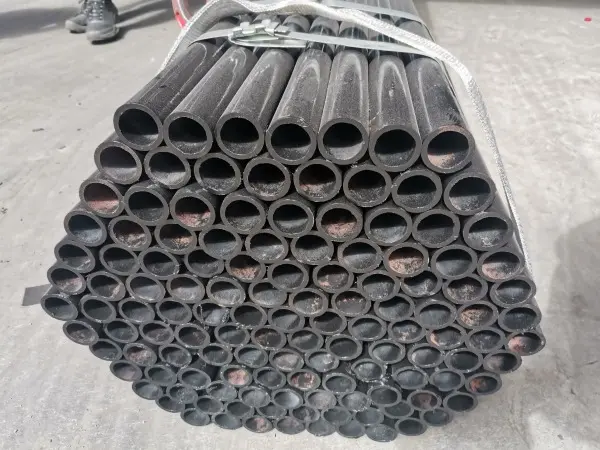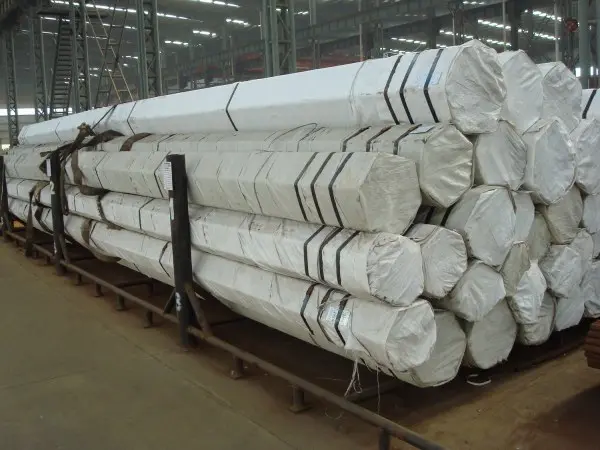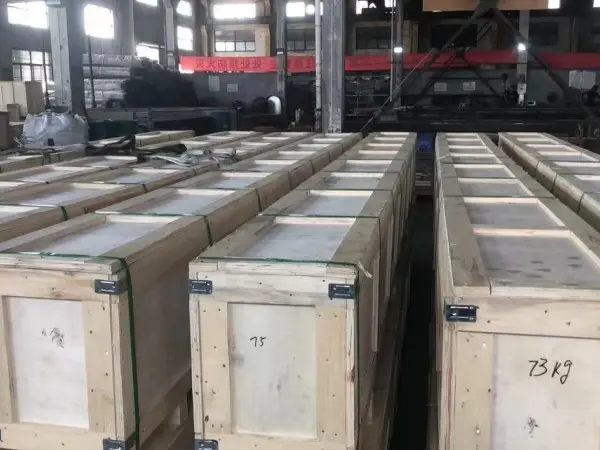- No.101 Wanbo 1st Road, Nancun Town, Panyu District, Guangzhou, Guangdong, China
- 0086-020-84886013,84886093,84886091,84886012
- sales@finegosteel.com
Seamless Steel Pipe
Boiler Steel Pipe
Product Dimension:
Cold finaished seamless tube and pipe: φ8-114.3×1~20mm
Hot-rolled steel tube and pipe: φ114.3~720×5-120mm
Uses: for manufacture wall panel. econcomizer, reheater superheater and steam pipeline of boilers
Outer Diameter (OD): 13.72-914.4mm
Wall Thickness(WT): 1.65-22mm
Length: 0.5mtr-20mtr
Pipe Standard: ASTM A179; ASTM A192; ASTM A210; ASTM A213; Grade T2/T5/T9/T11/T12/T22/T23/T24/T36/T9; EN10216/BS3059; JIS G3454/G3456/G3461
End: Square ends/plain ends (straight cut, saw cut, torch cut), beveled/threaded ends
Surface: Black painting/oil painting/anti-rust oil/anti-corrosive coating
Packing: Bundled, plastic caps plugged, waterproof paper/bag wrapped
Standard
Specification
Boiler steel pipe refers to a steel product with both ends open and having a hollow section. The length of the seamless boiler tube is relatively large compared to its surroundings. The specifications of the steel pipe are external dimensions (such as outer diameter or side length) and The wall thickness indicates a wide range of sizes, from capillary tubes with very small diameters to large-diameter tubes with diameters of several meters. Boiler steel tubes can be used in pipelines, thermal equipment, machinery industries, petroleum geology exploration, vessels, chemical industry and special applications.
Types:
General use/ medium-pressure boiler tubes, High-pressure boiler tubes
Characteristics:
Due to the high pressure application, only seamless pipes and ERW get used as boiler products.
Boiler pies are available in carbon steel, alloy, and stainless steel options.
The Outer Diameter of boiler pipes varies from 6 mm to 1250 mm.
Boiler pipes have a low thickness ranging from 1 mm to 50 mm.
Application:
Steam Boilers, Fossil Fuel Plants, Heat Exchangers, Electric Power Plants, Cogeneration Facilities, Air Preheater Unit, Waste Heat Plants, Power Generation, Economiser etc.
Standards & Grade:
|
Standards |
Grade |
|
DIN17175 |
St35.8,St45.8,15Mo3,13CrMo44,10CrMo910, 14MoV63,12Cr1MoV |
|
ASTM A106M ASME SA-106 |
A106B SA-106C |
|
ASTM A192 ASME SA-192M |
A192 SA-192 |
|
ASTM A179 ASME SA179 |
A179 SA179 |
|
ASTM A209M ASME SA-209M |
A209T1, A209T1b ,A 20T1a SA-209T1, SA-209T1b, SA-209T1a |
|
ATME A210M ASME SA-210M |
A.210A1, A2IOC SA-210A1,SA-210C |
|
ASTM A335 ASTM SA335 |
P1,P2,P5.P9,P11.P12,P21, P22,P23,P91,P92 |
|
ASTM A213M ASME SA-213M |
A213 T2, A213 T11, A213T12, A213 T22, A213 T23 SA-23 T2, SA213-T11, SA213-TI2, SA213-T22, SA213-T23 A213 T24, A213 T91, A213 T911, A213 T92,A213TI22, SA-213 T24, SA213-T11, SA213-T911, SA213-T92, SA213-T122 TP304H, TP32IH, TP347H, S30432, TP310HCbN |
|
EN 10216-2 |
P195GH, P235GH, P265GH, 16Mo3 10CrMo5-5, 13CrMo4-5, 10CrMo9-10, X10CrMoVNb9-1 |
|
JIS G3461 |
STB 340, STB410, STB510 |
|
JIA G3462 |
STBA 12, STBA I3, STBA 20C,STBA 22 STBA 23, STBA24, STBA26 |
|
JIS G3463 |
SUS304HTB, SUS321HTB |
Chemical Composition:
|
Steel Grade |
Chemical Composition % |
||||
|
|
C |
Mn |
P |
S |
Si |
|
A179/SA179 |
≤0.18 |
0.27-0.63 |
≤0.035 |
≤0.035 |
≤0.25 |
|
A192/SA192 |
≤0.18 |
0.27-0.63 |
≤0.035 |
≤0.035 |
≤0.25 |
|
A210/SA210 |
≤0.27 |
≤0.93 |
≤0.035 |
≤0.035 |
≥0.10 |
|
A556/SA556 B2 |
≤0.27 |
0.29-0.93 |
≤0.030 |
≤0.030 |
≥0.10 |
|
A556/SA556 C2 |
≤0.30 |
0.29-1.06 |
≤0.030 |
≤0.030 |
≥0.10 |
|
JIS G3456 STPT 480 |
≤ 0.33 |
0.30~1.00 |
≤ 0.035 |
≤ 0.035 |
0.10~0.35 |
|
JIS G3456 STPT 410 |
≤ 0.30 |
0.30~1.00 |
≤ 0.035 |
≤ 0.035 |
0.10~0.35 |
|
JIS G3456 STPT 370 |
≤ 0.25 |
0.30~0.90 |
≤ 0.035 |
≤ 0.035 |
0.10~0.35 |
|
JIS G3454 STPG 410 |
≤ 0.30 |
0.30~0.90 |
≤ 0.04 |
≤ 0.040 |
≤ 0.35 |
|
JIS G3454 STPG 370 |
≤ 0.25 |
0.30 ~0.90 |
≤ 0.04 |
≤ 0.040 |
≤ 0.35 |
|
JIS G3461 STB 510 |
≤ 0.25 |
1.00-1.50 |
≤ 0.035 |
≤ 0.035 |
≤ 0.35 |
|
JIS G3461 STB 410 |
≤ 0.32 |
0.30-0.80 |
≤ 0.035 |
≤ 0.035 |
≤ 0.35 |
|
JIS G3461 STB 340 |
≤ 0.18 |
0.30-0.60 |
≤ 0.035 |
≤ 0.035 |
≤ 0.3 |
|
EN 10216-1 Grade P195TR1 |
≤ 0.13 |
≤ 0.70 |
0.025 |
0.02 |
≤ 0.30 |
|
EN 10216-1 Grade P195TR2 |
≤ 0.13 |
≤ 0.70 |
0.025 |
0.015 |
≤ 0.30 |
|
EN 10216-1 Grade P235TR1 |
≤ 0.16 |
≤ 1.20 |
0.025 |
0.02 |
≤ 0.30 |
|
EN 10216-1 Grade P235TR2 |
≤ 0.16 |
≤ 1.20 |
0.025 |
0.015 |
≤ 0.30 |
|
EN 10216-1 Grade P265TR1 |
≤ 0.20 |
≤ 1.40 |
0.025 |
0.02 |
≤ 0.30 |
|
EN 10216-1 Grade P265TR2 |
≤ 0.20 |
≤ 1.40 |
0.025 |
0.015 |
≤ 0.30 |
|
EN 10216-2 Grade X10CrMoVNb9-1 |
0.08-0.12 |
0.20-0.50 |
0.30-0.60 |
0.02 |
0.005 |
|
EN 10216-2 Grade P265GH |
≤ 0.20 |
≤ 0.40 |
≤ 1.40 |
0.025 |
0.01 |
|
EN 10216-2 Grade 14MoV6-3 |
0.10-0.18 |
0.10-0.35 |
0.40-0.70 |
0.025 |
0.01 |
|
EN 10216-2 Grade 7CrWVMoNb9-6 |
0.04-0.10 |
≤ 0.5 |
0.10-0.60 |
0.03 |
0.01 |
|
EN 10216-2 Grade 7CrMoVTiB10-10 |
0.05-0.10 |
0.15-0.45 |
0.30-0.70 |
0.02 |
0.01 |
|
EN 10216-2 Grade 16Mo3 |
0.12-0.20 |
0.15-0.35 |
0.40-0.90 |
0.025 |
0.01 |
|
EN 10216-2 Grade 10CrMo5-5 |
≤ 0.15 |
0.50-1.00 |
0.30-0.60 |
0.025 |
0.01 |
|
EN 10216-2 Grade 13CrMo4-5 |
0.10-0.17 |
0.15-0.35 |
0.40-0.70 |
0.025 |
0.01 |
|
EN 10216-2 Grade 11CrMo9-10+QT |
0.08-0.15 |
≤ 0.5 |
0.40-0.80 |
0.025 |
0.01 |
|
EN 10216-2 Grade 25CrMo4 |
0.22-0.29 |
≤ 0.4 |
0.6-0.9 |
0.035 |
0.01 |
|
EN 10216-2 Grade X11CrMo5+I |
0.08-0.15 |
0.15-0.50 |
0.30-0.60 |
0.025 |
0.01 |
|
EN 10216-2 Grade X11CrMo5+NT1 |
0.08-0.15 |
0.15-0.50 |
0.30-0.60 |
0.025 |
0.01 |
|
EN 10216-2 Grade X11CrMo5+NT2 |
0.08-0.15 |
0.15-0.50 |
0.30-0.60 |
0.025 |
0.01 |
|
EN 10216-2 Grade P195GH |
≤ 0.13 |
≤ 0.35 |
≤ 0.70 |
0.025 |
0.01 |
|
EN 10216-2 Grade P235GH |
≤ 0.16 |
≤ 0.35 |
≤ 1.20 |
0.025 |
0.01 |
|
EN 10216-3 Grade P460NH |
≤ 0.20 |
≤ 0.60 |
1.00-1.70 |
0.025 |
0.01 |
|
EN 10216-3 Grade P460NL1 |
≤ 0.20 |
≤ 0.60 |
1.00-1.70 |
0.025 |
0.008 |
|
EN 10216-3 Grade P460NL2 |
≤ 0.20 |
≤ 0.60 |
1.00-1.70 |
0.025 |
0.005 |
|
EN 10216-3 Grade P275NL1 |
≤ 0.16 |
≤ 0.40 |
0.50-1.50 |
0.025 |
0.008 |
|
EN 10216-3 Grade P275NL2 |
≤ 0.16 |
≤ 0.40 |
0.50-1.50 |
0.025 |
0.005 |
|
EN 10216-3 Grade P355N |
≤ 0.20 |
≤ 0.50 |
0.90-1.70 |
0.025 |
0.02 |
|
EN 10216-3 Grade P355NH |
≤ 0.20 |
≤ 0.50 |
0.90-1.70 |
0.025 |
0.01 |
|
EN 10216-3 Grade P355NL1 |
≤ 0.18 |
≤ 0.50 |
0.90-1.70 |
0.025 |
0.008 |
|
EN 10216-3 Grade P355NL2 |
≤ 0.18 |
≤ 0.50 |
0.90-1.70 |
0.025 |
0.005 |
|
EN 10216-3 Grade P460N |
≤ 0.20 |
≤ 0.60 |
1.00-1.70 |
0.025 |
0.02 |
|
EN 10216-4 Grade P215NL |
≤ 0.15 |
≤ 0.35 |
0.40-1.20 |
0.03 |
0.01 |
|
EN 10216-4 Grade P265NL |
≤ 0.20 |
≤ 0.40 |
0.60-1.40 |
0.03 |
0.01 |
Process
However, high pressure boiler tubes are processed further to improve their corrosion resistance, toughness, and hardness. These pipes go through the following extra process compared to general boiler pipes/ medium-pressure boiler pipes.
Quenching- this process refers to the practice of instant cooling where heated pipes get dipped into water and oil for cooling. Quenching improves steel hardness as the pipes must adjust to the quick changes in surface temperature.
Tempering rids the pipe of the brittleness caused by quenching.
In annealing, the steel is heated to a specific temperature and left to cool slowly in lime. this process helps get rid of the pie's internal stress.

 Language
Language





